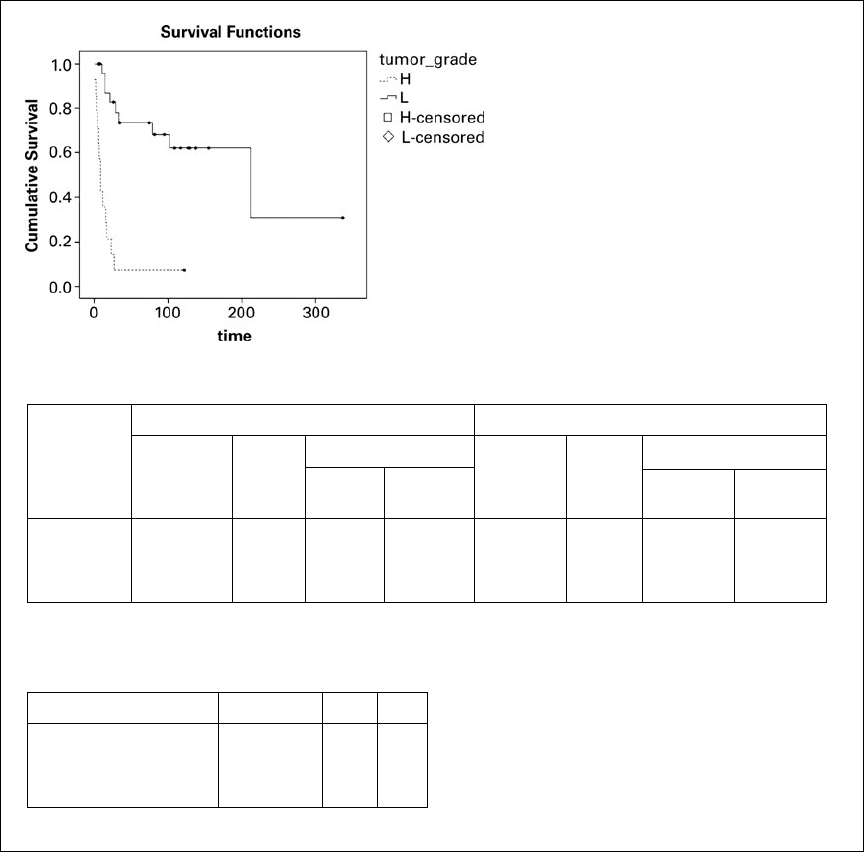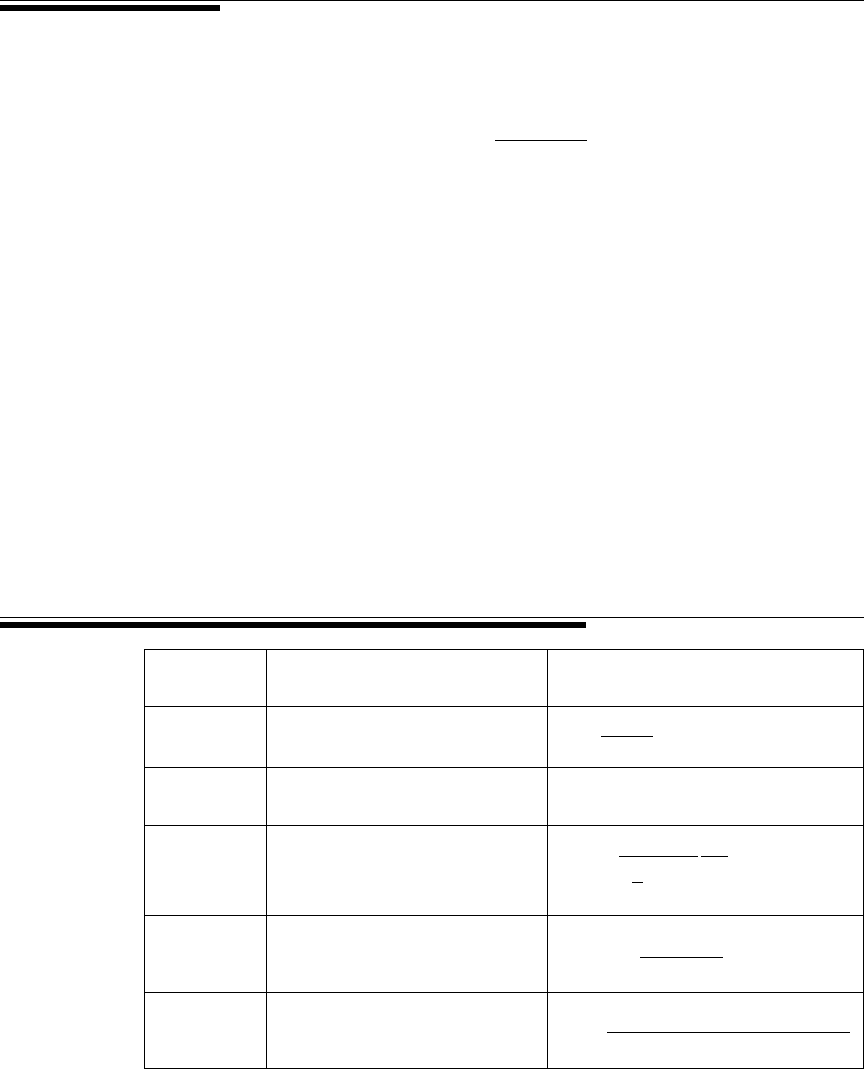Daniel W.W. Biostatistics: A Foundation for Analysis in the Health Sciences
Подождите немного. Документ загружается.


EXAMPLE 12.8.2
Let us refer again to the data on primary malignant tumors of the sternum presented
in Example 12.8.1. Examination of the data reveals that there are 20 time periods
(strata). For each of these a table following the pattern of Table 12.8.3 must be
constructed. The first of these tables is shown as Table 12.8.4. By Equations 12.7.5 and
12.7.6 we compute and as follows:
The data for Table 12.8.4 and similar data for the other 19 time periods are shown in
Table 12.8.5. Using data from Table 12.8.5, we compute the log-rank statistic by Equa-
tion 12.7.7 as follows:
Reference to Appendix Table F reveals that since the p value for this
test is We, therefore, reject the null hypothesis that the survival experience is
the same for patients with low-grade tumors and high-grade tumors and conclude that
they are different.
There are alternative procedures for testing the null hypothesis that two survival
curves are identical. They include the Breslow test (also called the generalized Wilcoxon
test) and the Tarone–Ware test. Both tests, as well as the log-rank test, are discussed in
Parmar and Machin (26). Like the log-rank test, the Breslow test and the Tarone–Ware test
are based on the weighted differences between actual and expected numbers of deaths at
6 .005.
24.704 7 7.879,
x
2
MH
=
19 - 17.8112
2
3.140
= 24.704
y
i
=
10 + 12125 + 13210 + 25211 + 132
39
2
1382
= .230
e
i
=
10 + 1210 + 252
39
= .641
y
i
e
i
2 * 2
12.8 SURVIVAL ANALYSIS 657
TABLE 12.8.3 Contingency Table for Stratum (Time)
t
i
for Calculating the
Log-Rank Test
Group A Group B Total
Number of deaths observed
Number of patients alive
Number of patients “at risk” n
i
= a
i
+ b
i
+ c
i
+ d
i
b
i
+ d
i
a
i
+ c
i
c
i
+ d
i
d
i
c
i
a
i
+ b
i
b
i
a
i
TABLE 12.8.4 Contingency Table for First Stratum (Time
Period) for Calculating the Log-Rank Test, Example 12.8.2
Low-Grade High-Grade Total
Deaths 0 1 1
Patients alive 25 13 38
Patients at risk 25 13 39

the observed time points. Whereas the log-rank test ranks all deaths equally, the Breslow
and Tarone–Ware tests give more weight to early deaths. For Example 12.8.1, SPSS com-
putes a value of for the Breslow test and a value of
for the Tarone–Ware test. Kleinbaum (27) discusses another test called the Peto test. For-
mulas for this test are found in Parmar and Machin (26). The Peto test also gives more
weight to the early part of the survival curve, where we find the larger numbers of sub-
jects at risk. When choosing a test, then, researchers who want to give more weight to the
earlier part of the survival curve will select either the Breslow, the Tarone–Ware, or the
Peto test. Otherwise, the log-rank test is appropriate.
We have covered only the basic concepts of survival analysis in this section. The
reader wishing to pursue the subject in more detail may consult one or more of several
books devoted to the topic, such as those by Kleinbaum (27), Lee (28), Marubini and
Valsecchi (29), and Parmar and Machin (26).
Computer Analysis
Several of the available statistical software packages, such as SPSS, are capable of per-
forming survival analysis and constructing supporting graphs as described in this section.
A standard SPSS analysis of the data discussed in Examples 12.8.1 and 12.8.2 is
shown in Figure 12.8.3.
■
25.22 1p = .0000224.93 1p = .00002
658 CHAPTER 12 THE CHI-SQUARE DISTRIBUTION AND THE ANALYSIS OF FREQUENCIES
TABLE 12.8.5 Intermediate Calculations for the Log-Rank Test, Example 12.8.2
Time,
0 0 25 25 1 13 14 39 0.641 0.230
2 0 25 25 1 12 13 38 0.658 0.225
3 0 25 25 1 11 12 37 0.676 0.219
4 0 25 25 1 10 11 36 0.694 0.212
6 0 25 25 1 9 10 35 0.714 0.204
7 0 24 24 1 8 9 33 0.727 0.198
9 0 23 23 2 6 8 31 1.484 0.370
11 1 22 23 0 6 6 29 0.793 0.164
12 0 22 22 1 5 6 28 0.786 0.168
15 2 20 22 0 5 5 27 1.630 0.290
16 0 20 20 1 4 5 25 0.800 0.160
17 0 20 20 1 3 4 24 0.833 0.139
21 1 19 20 0 3 3 23 0.870 0.113
23 0 19 19 1 2 3 22 0.864 0.118
27 0 18 18 1 1 2 20 0.900 0.090
29 1 17 18 0 1 1 19 0.947 0.050
33 1 16 17 0 1 1 18 0.944 0.052
79 1 13 14 0 1 1 15 0.933 0.062
102 1 10 11 0 1 1 12 0.917 0.076
212 1 1 2 0 0 0 2 1.000 0.000
Totals 9 17.811 3.140
y
i
e
i
n
i
b
i
d
i
d
i
b
i
a
i
+ c
i
c
i
a
i
t
i

The Proportional Hazards or Cox Regression Model In previous
chapters, we saw that regression models can be used for continuous outcome measures
and for binary outcome measures (logistic regression). Additional regression techniques
are available when the dependent measures may consist of a mixture of either time-until-
event data or censored time observations. Returning to our example of a clinical trial of
the effectiveness of two different medications to prevent a second myocardial infarction,
we may wish to control for additional characteristics of the subjects enrolled in the study.
12.8 SURVIVAL ANALYSIS 659
Means and Medians for Survival Time
Mean
a
Median
95% Confidence Interval 95% Confidence Interval
tumor_ Std. Lower Upper Std. Lower Upper
grade Estimate Error Bound Bound Estimate Error Bound Bound
H 18.357 8.251 2.186 34.528 9.000 1.852 5.371 12.629
L 88.040 15.258 58.134 117.946 82.000 16.653 49.359 114.641
Overall 63.026 11.490 40.505 85.546 27.000 7.492 12.317 41.683
a
Estimation is limited to the largest survival time if it is censored.
Overall Comparisons
Chi-Square df Sig.
Log Rank (Mantel-Cox) 24.704 1 .000
Breslow (Generalized
Wilcoxon) 24.927 1 .000
Tarone-Ware 25.217 1 .000
Test of equality of survival distributions for the different levels of tumor_grade.
FIGURE 12.8.3 SPSS output for Examples 12.8.1 and 12.8.2.

For example, we would expect subjects to be different in their baseline systolic blood
pressure measurements, family history of heart disease, weight, body mass, and other
characteristics. Because all of these factors may influence the length of the time interval
until a second myocardial infarction, we would like to account for these factors in deter-
mining the effectiveness of the medications. The regression method known as Cox regres-
sion (after D. R. Cox, who first proposed the method) or proportional hazard regression
can be used to account for the effects of continuous and discrete covariate (independent
variable) measurements when the dependent variable is possibly censored time-until-
event data.
We describe this technique by first introducing the hazard function, which describes
the conditional probability that an event will occur at a time just larger than condi-
tional on having survived event-free until time This conditional probability is also
known as the instantaneous failure rate at time and is often written as the function
The regression model requires that we assume the covariates have the effect of
either increasing or decreasing the hazard for a particular individual compared to some
baseline value for the function. In our clinical trial example we might measure k covari-
ates on each of the subjects where there are subjects and is the base-
line hazard function. We describe the regression model as
(12.8.3)
The regression coefficients represent the change in the hazard that results from
the risk factor, that we have measured. Rearranging the above equation shows that
the exponentiated coefficient represents the hazard ratio or the ratio of the conditional
probabilities of an event. This is the basis for naming this method proportional haz-
ards regression. You may recall that this is the same way we obtained the estimate of
the odds ratio from the estimated coefficient when we discussed logistic regression in
Chapter 11.
(12.8.4)
Estimating the covariate effects, requires the use of a statistical software package
because there is no straightforward single equation that will provide the estimates
for this regression model. Computer output usually includes estimates of the regres-
sion coefficients, standard error estimates, hazard ratio estimates, and confidence
intervals. In addition, computer output may also provide graphs of the hazard func-
tions and survival functions for subjects with different covariate values that are use-
ful to compare the effects of covariates on survival. In summary, Cox regression is a
useful technique for determining the effects of covariates with survival data. Addi-
tional information can be found in the texts by Kleinbaum (27), Lee (28), Kalbfleisch
and Prentice (30), Elandt-Johnson and Johnson (31), Cox and Oakes (32), and Fleming
and Harrington (33).
b
N
h1t
i
2
h
0
1t
i
2
= exp1b
1
z
i1
+ b
2
z
i2
+
Á
+ b
k
z
ik
2
z
ik
,
h1t
i
2= h
0
1t
i
2exp1b
1
z
i1
+ b
2
z
i2
+
Á
+ b
k
z
ik
2
h
0
1t
i
2I = 1,...,n
h1t
i
2.
t
i
t
i
.
t
i
660 CHAPTER 12 THE CHI-SQUARE DISTRIBUTION AND THE ANALYSIS OF FREQUENCIES

EXERCISES
12.8.1 Fifty-three patients with medullary thyroid cancer (MTC) were the subjects of a study by Dot-
torini et al. (A-24), who evaluated the impact of different clinical and pathological factors and the
type of treatment on their survival. Thirty-two of the patients were females, and the mean age of
all patients was 46.11 years with a standard deviation of 14.04 (range 18–35 years). The follow-
ing table shows the status of each patient at various periods of time following surgery. Analyze
the data using the techniques discussed in this section.
Subject Time
a
(Years) Status
b
Subject Time
a
(Years) Status
b
1 0 doc 28 6 alive
2 1 mtc 29 6 alive
3 1 mtc 30 6 alive
4 1 mtc 31 6 alive
5 1 mtc 32 7 mtc
6 1 mtc 33 8 alive
7 1 mtc 34 8 alive
8 1 mtc 35 8 alive
9 1 alive 36 8 alive
10 2 mtc 37 8 alive
11 2 mtc 38 9 alive
12 2 mtc 39 10 alive
13 2 alive 40 11 mtc
14 2 alive 41 11 doc
15 3 mtc 42 12 mtc
16 3 mtc 43 12 doc
17 3 alive 44 13 mtc
18 4 mtc 45 14 alive
19 4 alive 46 15 alive
20 4 alive 47 16 mtc
21 4 alive 48 16 alive
22 5 alive 49 16 alive
23 5 alive 50 16 alive
24 5 alive 51 17 doc
25 5 alive 52 18 mtc
26 6 alive 53 19 alive
27 6 alive
a
Time is number of years after surgery.
b
doc dead of other causes; mtc dead of medullary thyroid cancer.
Source: Dr. Massimo E. Dottorini. Used with permission.
12.8.2 Banerji et al. (A-25) followed non–insulin-dependent diabetes mellitus (NIDDM) patients from
onset of their original hyperglycemia and the inception of their near–normoglycemic remission fol-
lowing treatment. Subjects were black men and women with a mean age of 45.4 years and a stan-
dard deviation of 10.4. The following table shows the relapse/remission experience of 62 subjects.
Use the techniques covered in this section to analyze these data.
==
EXERCISES 661

Total Total Total
Duration of Duration of Duration of
Remission Remission Remission Remission Remission Remission
(Months) Status
a
(Months) Status
a
(Months) Status
a
3 1 82261
3 2 92271
3 1101282
3 1101291
3 1112312
4 1131311
4 1161332
4 1162392
5 1172411
5 1182441
5 1201461
5 1221462
5 1222481
5 1222482
5 1231481
6 1242491
6 1252501
6 1252531
7 1261702
8 2261941
81
82
a
1 yes (the patient is still in remission); 2 no (the patient has relapsed).
Source: Dr. Mary Ann Banerji. Used with permission.
12.8.3 If available in your library, read the article, “Impact of Obesity on Allogeneic Stem Cell Transplant
Patients: A Matched Case-Controlled Study,” by Donald R. Fleming et al. [American Journal of
Medicine, 102 (1997), 265–268] and answer the following questions:
(a) How was survival time determined?
(b) Why do you think the authors used the Wilcoxon test (Breslow test) for comparing the sur-
vival curves?
(c) Explain the meaning of the p values reported for Figures 1 through 4.
(d) What specific statistical results allow the authors to arrive at their stated conclusion?
12.8.4 If available in your library, read the article, “Improved Survival in Patients with Locally Advanced
Prostate Cancer Treated with Radiotherapy and Goserelin,” by Michel Bolla et al. [New England
Journal of Medicine, 337 (1997), 295–300], and answer the following questions:
(a) How was survival time determined?
(b) Why do you think the authors used the log-rank test for comparing the survival curves?
662 CHAPTER 12 THE CHI-SQUARE DISTRIBUTION AND THE ANALYSIS OF FREQUENCIES

(c) Explain the meaning of the p values reported for Figures 1 and 2.
(d) What specific statistical results allow the authors to arrive at their stated conclusion?
12.8.5 Fifty subjects who completed a weight-reduction program at a fitness center were divided into
two equal groups. Subjects in group 1 were immediately assigned to a support group that met
weekly. Subjects in group 2 did not participate in support group activities. All subjects were fol-
lowed for a period of 60 weeks. They reported weekly to the fitness center, where they were
weighed and a determination was made as to whether they were within goal. Subjects were con-
sidered to be within goal if their weekly weight was within 5 pounds of their weight at time of
completion of the weight-reduction program. Survival was measured from the date of completion
of the weight-reduction program to the termination of follow-up or the point at which the sub-
ject exceeded goal. The following results were observed:
Status Status
(G Within Goal (G Within Goal
Time GExceeded Goal Time GExceeded Goal
Subject (Weeks) L Lost to Follow-Up) Subject (Weeks) L Lost to Follow-Up)
Group 1 Group 2
160 G 120 G
232 L 226 G
360 G 310 G
422 L 42 G
56 G+ 536 G
660 G 610 G
760 G 720 G
8 20 G+ 8 18 L
9 32 G+ 9 15 G
10 60 G 10 22 G
11 60 G 11 4 G
12 8 G+ 12 12 G
13 60 G 13 24 G
14 60 G 14 6 G
15 60 G 15 18 G
16 14 L 16 3 G
17 16 G+ 17 27 G
18 24 L 18 22 G
19 34 L 19 8 G
20 60 G 20 10 L
21 40 L 21 32 G
22 26 L 22 7 G
23 60 G 23 8 G
24 60 G 24 28 G
25 52 L 25 7 G
Analyze these data using the methods discussed in this section.
EXERCISES 663

12.9 SUMMARY
In this chapter some uses of the versatile chi-square distribution are discussed. Chi-square
goodness-of-fit tests applied to the normal, binomial, and Poisson distributions are pre-
sented. We see that the procedure consists of computing a statistic
that measures the discrepancy between the observed and expected frequencies of
occurrence of values in certain discrete categories. When the appropriate null hypothesis is
true, this quantity is distributed approximately as When is greater than or equal to
the tabulated value of for some the null hypothesis is rejected at the level of sig-
nificance.
Tests of independence and tests of homogeneity are also discussed in this chapter.
The tests are mathematically equivalent but conceptually different. Again, these tests
essentially test the goodness-of-fit of observed data to expectation under hypotheses,
respectively, of independence of two criteria of classifying the data and the homogene-
ity of proportions among two or more groups.
In addition, we discussed and illustrated in this chapter four other techniques for
analyzing frequency data that can be presented in the form of a contingency table:
the Fisher exact test, the odds ratio, relative risk, and the Mantel–Haenszel procedure.
Finally, we discussed the basic concepts of survival analysis and illustrated the compu-
tational procedures by means of two examples.
SUMMARY OF FORMULAS FOR CHAPTER 12
Formula
Number Name Formula
12.2.1 Standard normal random variable
12.2.2 Chi-square distribution with n
degrees of freedom
12.2.3 Chi-square probability density
function
12.2.4 Chi-square test statistic
12.4.1 Chi-square calculation formula
for a 2 2 contingency table x
2
=
n1ad - bc2
2
1a + c21b + d21a + b21c + d2
x
2
=
a
c
1O
i
- E
i
2
2
E
i
d
f1u2=
1
a
k
2
- 1b!
1
2
k>2
u
1k>22-1
e
-1u>22
x
2
1n2
= z
2
1
+ z
2
2
+
Á
+ z
2
n
z
i
=
y
i
- m
s
2 * 2
aa,x
2
X
2
x
2
.
1E
i
21O
i
2
X
2
=
a
c
1O
i
- E
i
2
2
E
i
d
664 CHAPTER 12 THE CHI-SQUARE DISTRIBUTION AND THE ANALYSIS OF FREQUENCIES

12.4.2 Yates’s corrected
chi-square calcu-
lation for a 2 2
contingency table
12.6.1–12.6.2 Large-sample
approximation
to the chi-square
12.7.1 Relative risk
estimate
12.7.2 Confidence
interval for the
relative risk
estimate
12.7.3 Odds ratio
estimate
12.7.4 Confidence
interval for the
odds ratio
estimate
12.7.5 Expected
frequency in
the Mantel–
Haenszel statistic
12.7.6 Stratum expected
frequency in the
Mantel–Haenszel
statistic
12.7.7 Mantel–Haenszel
test statistic
12.7.8 Mantel–Haenszel
estimator of the
common odds ratio
OR
MH
=
a
k
i = 1
1a
i
d
i
>n
i
2
a
k
i = 1
1b
i
c
i
>n
i
2
x
2
MH
=
a
a
k
i = 1
a
i
-
a
k
i = 1
e
i
b
a
k
i = 1
v
i
v
i
=
1a
i
+ b
i
21c
i
+ d
i
21a
i
+ c
i
21b
i
+ d
i
2
n
2
i
1n
i
- 12
e
i
=
1a
i
+ b
i
21a
i
+ c
i
2
n
i
10011 - a2%CI = OR
1; 1z
a
>1x
2
2
10011 - a2%CI = RR
1; 1z
a
>1x
2
2
x
2
corrected
=
n1
ƒ
ad - bc
ƒ
-.5n2
2
1a + c21b + d21a + b21c + d2
SUMMARY OF FORMULAS FOR CHAPTER 12 665
where
p
N
= 1a + b2>1A + B2
z =
1a>A2- 1b>B2
2p
N
11 - p
N
211>A + 1>B2
(Continued)
RR =
a>1a + b2
c>1c + d2
OR =
a>b
c>d
=
ad
bc

12.8.1 Survival number of subjects surviving at least (t 1) time period
probability
12.8.2 Estimated
survival
function
12.8.3 Hazard
regression
model
12.8.4 Proportional
hazard model
Symbol • a, b, c, d cell frequencies in a 2 2 contingency table
Key • A, B row totals in the 2 2 contingency table
• regression coefficient
• (or X
2
) chi-square
• e
i
expected frequency in the Mantel–Haenszel statistic
• E
i
expected frequency
• expected value of y at x
• k degrees of freedom in the chi-square distribution
• mean
• O
i
observed frequency
• OR odds ratio estimate
• standard deviation
• RR relative risk estimate
• v
i
stratum expected frequency in the Mantel–Haenszel statistic
• y
i
data value at point i
• z normal variate
REVIEW QUESTIONS AND EXERCISES
1. Explain how the chi-square distribution may be derived.
2. What are the mean and variance of the chi-square distribution?
3. Explain how the degrees of freedom are computed for the chi-square goodness-of-fit tests.
4. State Cochran’s rule for small expected frequencies in goodness-of-fit tests.
5. How does one adjust for small expected frequencies?
6. What is a contingency table?
7. How are the degrees of freedom computed when an value is computed from a contingency
table?
X
2
s
m
E
1y
ƒ
x2
x
2
b
h1t
i
2
h
0
1t
i
2
= exp1b
1
z
i1
+ b
2
z
i2
+
Á
+ b
k
z
ik
2
h1t
i
2= h
0
1t
i
2exp1b
1
z
i1
+ b
2
z
i2
+
Á
+ b
k
z
ik
2
S
N
1t2= p
1
N
* p
2
N
*
Á
* p
t
N
666 CHAPTER 12 THE CHI-SQUARE DISTRIBUTION AND THE ANALYSIS OF FREQUENCIES
p
1
N
=
who also survive t
th
period
number of subjects alive at end of time period 1t - 12
